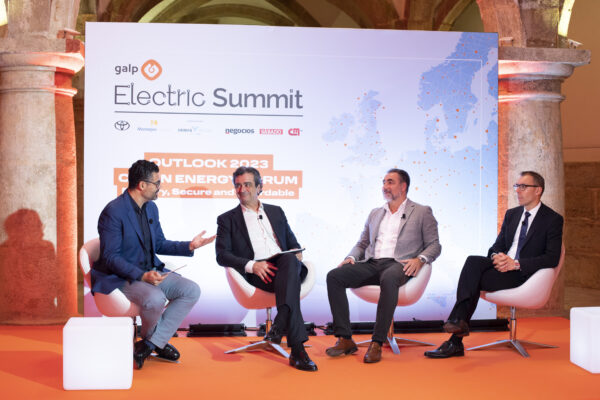Financing and governance as tools to guarantee energy transition
Ana Sousa (CERENA-IST, Catarina Vazão (Get2C and Trade2C), Jorge Vasconcelos (New Energy Solutions), Rodrigo Vilanova (Galp) and Victor Moure (Schneider Electric), point the way towards accelerating the much-desired energy transition.
Sustainability is no longer a fantasy or just a word bandied about in the business world but hardly ever implemented. Today, sustainability is a part of companies’ business plan and viability, not only in the medium and long term, but right now. There are issues which are particularly important, such as financing, the speed at which energy transition will take place and how it will actually happen.
During the panel on ‘The future of energy – how to guarantee an energy transition’, Rodrigo Vilanova, the executive vice-president of Energy Management at Galp, assured us that the Paris Agreement – which aims to achieve the decarbonisation of world economies and stipulates one of its long-term aims as limiting the rise in the average global temperature to less than 2ºC above pre-industrial levels – is pointing in a clear direction. “In Europe, when compared with other markets, not only is there an awareness but also a structuring, an organisation and regulation which create proper economic incentives. The best way of achieving and accelerating these goals is by having the right mechanisms and public policies in place to foster and facilitate energy transition.”
Companies unable to fulfil requirements
Catarina Vazão, a Partner at Get2C and Trade2C, reminded us that when the Roadmap for Carbon Neutrality was drawn up in 2018, it was apparent that everyone would have to make an effort, both in the public and private sectors, from companies and local authorities to the average citizen. “This effort implies a great deal of investment”, she said. “When discussing climate finance, we have to address training, raising awareness, and making everyone aware that these tools exist”. Catarina Vazão feels that these mechanisms, both at European and national level – such as the Environment Fund and even the RRP [Recovery and Resilience Plan] – have boosted companies’ performance, “by setting out their plans and strategies and identifying financing opportunities.”
She accepts that companies have very little time to prepare themselves for all the obligations and demands involved in this kind of financing, as well as the fact that the vast majority understand that they won’t be able to fulfil all these requirements. “It would be especially important, when applying for funding, to have a broad discussion to understand the needs of each type of entity and what its limitations are, so that a realistic application can be put together.”
Less is more
Jorge Vasconcelos, CEO, NEWES, New Energy Solutions, agreed with Catarina Vazão’s vision, and even said there is “too much unwarranted red tape.” He clarified that when discussing energy transition, the first basic principle is sufficiency, in the sense that we should try to cut back our demand for energy and use only what is necessary.
In fact, Jorge Vasconcelos praised the organisers for entitling this panel discussion ‘How to guarantee an energy transition’’ since he feels that there is not just one but multiple transitions. “It’s an important point. There is no one-size-fits-all way to make this transition. There are degrees of freedom which we have to exercise, and it’s a civic responsibility. In a democracy we have that right.”
He clarified: on one hand we have technical apparatus such as air conditioning, batteries, cars and heat pumps. Then there is another equally important dimension, which is the institutional aspect. “The most interesting thing is looking at the interaction between the two and understanding how new technologies can help to develop energy markets and how this market development can encourage new technologies, namely clean tech.”
According to Jorge Vasconcelos, one sphere where we can accelerate transition in a more cost-efficient way is the electrification of hot and cold, and of mobility. “This will essentially be in urban areas, which have the greatest needs.” In other words, it is implemented locally, where he feels governance needs to be reinvented at intermunicipal level. “This is where it has to start, and the rest will follow.”
A clean kw is one which isn’t consumed
The residential sector currently consumes around 20% of the energy total – a relatively low percentage of global consumption. This is why Ana Sousa, a researcher with Centro de Recursos Naturais e Ambiente (CERENA-IST) at the Instituto Superior Técnico, believes that the greatest change in cutting emissions has to be made in transport and industry.
In the residential sector, Ana Sousa identified a problem of energy literacy. “There’s a help desk to assist in submitting funding applications”, but private individuals must first make the investment themselves before then having a certain percentage of the amount refunded. Schools and universities could play a key role in promoting energy literacy.
A clean Kilowatt is one which isn’t consumed. So said Victor Moure, the Country Manager of the Portuguese arm of Schneider Electric at this panel moderated by André Macedo. “It might seem trivial or just a bit of wordplay, but the reality is that buildings are responsible for 40% of Co2 emissions”. Which is why it is crucial for companies to focus on energy-efficient systems, as well as optimising the management of production efficiency processes. The problem, Moure insisted, is that there are not yet many managers committed to this aim and prepared to make the necessary investment.
Going beyond the targets
Rodrigo Vilanova, the executive vice-president – Energy Management at Galp, explained to the audience that the company has a new purpose, as set out in its slogan ‘Let’s regenerate the future together’, and accomplished via the fact that 50% of the company CAPEX is already in low or zero-carbon investment. “We have also set targets for reducing carbon intensity, net zero in 2050, but there will already be a 40% reduction by 2025.” Nevertheless, Rodrigo Vilanova believes that the aim goes way beyond these targets. “It’s not just cutting our emissions, it’s also making it feasible for our customers, partners and society to make their own cuts.”
According to this executive, making company managers and heads aware of what needs to be done is key, but when we address the issue at a more fragmented level – individual consumers – although raising awareness is important, what is absolutely vital is to provide an economic incentive.
He agrees that the two main areas to focus on in order to accelerate the transition are buildings and light transport. “When we look towards more difficult areas, such as heavy transport and some industries, then we have to talk about decarbonising liquid and gas fuels.” This is the big league, which encompasses hydrogen, vegetable oil, and synthetic fuels, among other things. “We have to have incentives to make a structural change in the easier aspects, such as light transport and buildings, but also in those which are more difficult, such as heavy transport and some industrial sectors.”











